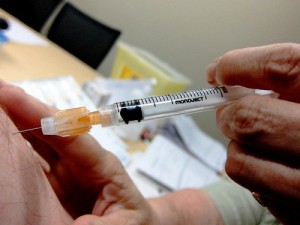A consensus statement and call to action to help healthcare personnel avoid needlesticks has been issued by the American Nurses Association and the International Healthcare Worker Safety Center at the University of Virginia.
The statement is meant to be “a roadmap for future progress,” according to this article on Nurse.com.
The consensus statement and call to action highlights five especially important areas to address. They are improving sharps safety in surgical settings; understanding and reducing exposure risks in nonhospital settings; involving frontline healthcare workers in the selection of safety devices; addressing gaps in safety devices and encouraging innovative design and technology; and enhancing worker education and training.
The president of ANA, Karen Daley, RN, PhD, MPH, FAAN, contracted HIV and hepatitisC from a needle while tending to a patient in the Emergency Department in 1998. Ever since then she has been a staunch advocate for needlestick safety.
“Needlestick injuries are preventable and cannot be tolerated as a cost of doing business,” Daley said in an ANA news release. “Healthcare organizations are charged with ensuring safety and preventing harm — to patients, employees and the public. Unfortunately, needlesticks still occur, whether from lack of education and training, complacency or frugality.”
The federal Needlestick Safety and Prevention Act was passed in 2000, a boost in the effort to reduce the risk of healthcare worker exposure to blood-borne pathogens. But Daley said the law does not by itself ensure worker safety.
“Nurses need to hold employers accountable for following the law and refuse to accept anything less,” she said. “Progress has been made, but the law provides only a framework. It is up to people to create the culture of safety necessary to minimize incidents.”
Healthcare workers in nonhospital settings account for about 65% of the U.S. healthcare workforce, a proportion that will continue to grow over the next decade. Although safety-engineered devices are in widespread use in most hospitals and clinical laboratories, market data show a lag in their use in other settings.
The U.S. Centers for Disease Control and Prevention, the National Institute for Occupational Safety and Health and other government agencies, as well as nongovernmental agencies and professional organizations, should support epidemiological research that evaluates risks to workers in a wide range of nonhospital settings, according to the statement. And professional organizations representing nonhospital care settings should make sharps safety a priority and ensure availability of appropriate devices and educational and training materials specifically for workers in these settings.
“While we celebrate the progress we have made, we must acknowledge the gaps that exist,” Jagger said in the news release. “We must redouble our efforts to ensure that all healthcare workers, regardless of the setting in which they practice or the procedures they perform, are offered the same standard of protection from sharps injuries and exposures to blood-borne pathogens.”

